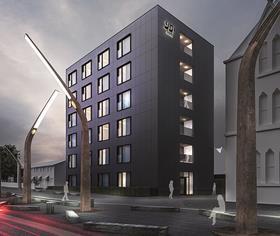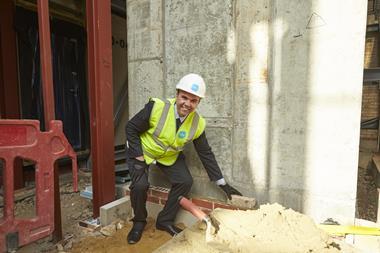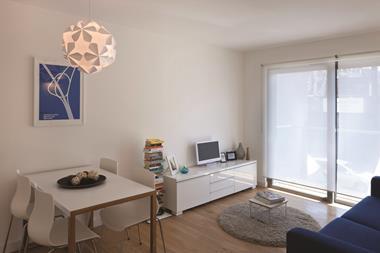Modular construction has been heralded as the cure-all for everything from housing refugees to making homes greener. Ahead of the topic being debated at RESI 2016, Property Week investigates if it can live up to the hype?

Plagued by sleepless nights over the government’s promise to build one million homes by 2020, new housing minister Gavin Barwell is urging developers to use modern methods of construction (MMCs) to speed things along.
However, a lack of prefab factories - critical for the construction of the modular units - could hold back plans to crank out more homes at the rate needed.
To blossom, housebuilders need to adopt off-site methods at scale. But funding sheds and robotics to enable this is highly capital intensive and without demand these facilities will simply not stack up.
“You’ve got to win the confidence of the banks and investors who need to feel that this isn’t laden with risk,” says Ray Theakston, construction director at Essential Living.
“Once a few have been built, confidence will grow and modular construction will become the rule rather than an exception.”
To build at scale, developers need consolidated production lines that can churn out entire apartments ready to go on site. Slotting them in like Meccano offers a wealth of benefits, not least the time spent on site.
But this requires considerable upfront investment. “The real game-changer is the disruptive intervention from institutional investors and local authority funds into direct lending to housing programmes that will involve creating completely new factories to build homes,” says Mark Cleverly, partner at Arcadis.
Fulfilling ambitious housing targets
Near Leeds, Legal & General (L&G) is planning to pump £55m into Europe’s largest off-site facility. As encouraging as this is, an assembly line churning out 3,000 homes a year will only see off a fraction of Britain’s housing need.

But L&G’s plans do offer a workable prototype for the type of model that would need to be replicated across the country to genuinely fulfil ambitious housing targets.
James Lidgate, L&G’s head of residential, is upbeat about the potential to create economies of scale and remove many issues faced on site, for instance due to interaction between certain trades. “You can remove that uncertainty and interaction in a factory environment,” he says.
Ambitious projects around the world offer a glimpse of what Britain’s construction future could look like.
In Singapore, a subsidiary of Bouygues is building two 40-storey modular apartment blocks based on a reinforced concrete structure.
In Dubai, a 3D printer two storeys tall was used to create a 2,700 sq ft office using a mix of concrete, fibre-reinforced plastic and glass-fibre-reinforced gypsum.
And in Sweden, Lindbäcks has gone a step further with fully automated production lines that can incorporate a mix of materials to build highly complex modifiable units for student and senior living.
Britain’s housing crisis
However, some of these innovations may not be appropriate for the UK, and especially London, where much of Britain’s housing need is concentrated. 3D printing, for example, does not lend itself to inner-city development.
“Factors such as location and planning requirements come into play on brownfield sites in particular, so to accommodate the necessary criteria as well as producing homes at volume, any 3D-capable facilities will need to take a flexible approach,” says Cliff Davey, estimating director at McLaren Construction.

“If everything is pre-planned properly and designed to meet all of these requirements as well as lifespan expectations, the construction would certainly be quicker while meeting the need for a housing demand that is more than double the current output.”
Regardless of whatever high-tech geekery we conjure up to build apartments, we’ll still need boots on the ground to assemble them.
“There will be less requirement for skilled labour as construction evolves towards on-site assembly. But only if projects are designed this way from the outset,” says Arcadis’s Cleverly.
“Off-site manufacture only represents 7% of construction output - in fact, the industry itself is reporting its own skills shortage.”
Over the long run, MMCs could transform the skills base needed by spreading the load across a broader array of functions. “A modern, capacity-enhanced industry will require both traditional trade skills as well as new forms of multi-skilled, digitally enabled manufacturing and assembly skills,” says Mark Farmer, director at Cast Consultancy.

If investors see demand increasing, the government skills review being led by Farmer may need to look at incorporating high-tech apprenticeships focusing on assembly.
While it’s clear that off-site manufacture has the potential to contribute heavily to Britain’s housing supply, the main hurdles will be making full use of existing factories and convincing lenders around risk.
Shifting investors towards homes that roll off a production line complete with a kitchen and bathroom shouldn’t be difficult. And if the market’s stars align, we may soon see a day where we can have customisable, high-quality homes within days. Maybe then the housing target will cause Lewis and his colleagues fewer sleepless nights.
Visit the RESI website for more information
































No comments yet